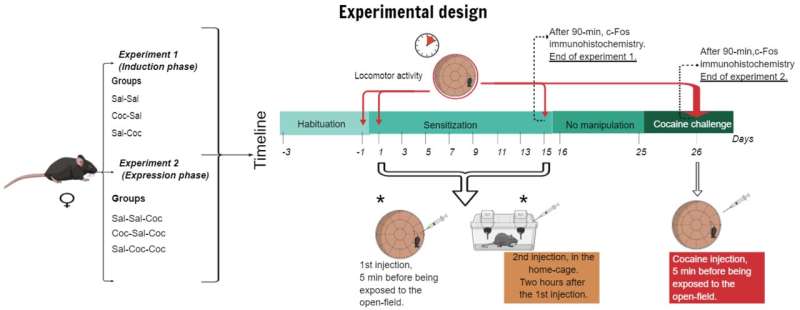Experimental designs of the induction (experiment 1) and expression (experiment 2) phase of cocaine-induced hyperlocomotion with a timeline. Groups were distributed according to the experiment. (*) Represents that the first and second injection during the sensitization period was administered concerning the group treatment. Both injections were applied on the same day. During the sensitization period, the injections were applied on the odd days (1, 3, 5, 7, 9, 11, 13, and 15). The first injection was applied in the open-field and two hours later in the animal´s home-cage. On the even days (2, 4, 6, 8, 10, 12, and 14), animals were not handled. Credit: Biomedicines (2023). DOI: 10.3390/biomedicines11020383
Scientists have identified the brain structures responsible for compulsive drug-seeking behaviors due to repeated use of cocaine. The findings, published in Biomedicines, identifies the structures involved and neural pathways activated with repeated exposure to the drug. Researchers hope the study could help inform treatment for drug addiction.
Researchers from the Federal University of São Paulo, Brazil, and the University of Bristol Veterinary School, UK, aimed to identify the brain structures involved in behavioral responses to cocaine. Scientists believe the phenomenon underpins abusers compulsive desire for the drug by causing changes in several areas of the brain's neural pathways which mediate reward and adaptive behaviors.
Using animal models and an innovative state-of-the-art 3D quantitative image analysis, known as stereology, the team were able to identify the specific areas of the brain activated when these were repeatedly exposed to cocaine.
Their results show the brain's dorsomedial prefrontal cortex (dmPFC), the nucleus accumbens core (NAc core) and the basolateral amygdala (BLA) participate in both the developing phase (induction) and the expression phase of behavioral responses to cocaine, while the ventral area of the mesencephalic tegument (VTA) has greater participation in the induction phase only.
The findings indicate repeated use of cocaine leads to associate learning, so an individual associates the euphoric effect promoted by the drug with the environment where it is consumed. As a result, a reinforcing system is established, meaning that two stimuli will be associated with choice or compulsive desire for the drug. The environment, therefore, plays a key role in the activation and expression of behavioral responses to cocaine.
Professor Beatriz Longo from the Federal University of São Paulo, the lead author of this study, Dr. Renan Baldaia, the first author of the article, and Dr. Augusto Coppi, a world-leader in 3D quantitative image analysis and Lecturer in Veterinary Clinical Anatomy at the University of Bristol, said, "Understanding behavioral changes involved in drug addiction, as well as identifying the brain structures involved in such behaviors in animal models, opens up possibilities for new therapeutic tools and interventions in the management of drug addiction."
The team hope to continue their work in identifying other brain structures involved in behavioral responses to other drugs, such as alcohol, marijuana and nicotine.
More information: Renan dos Santos-Baldaia et al, Distinctive Neuroanatomic Regions Involved in Cocaine-Induced Behavioral Sensitization in Mice, Biomedicines (2023). DOI: 10.3390/biomedicines11020383
Provided by University of Bristol























